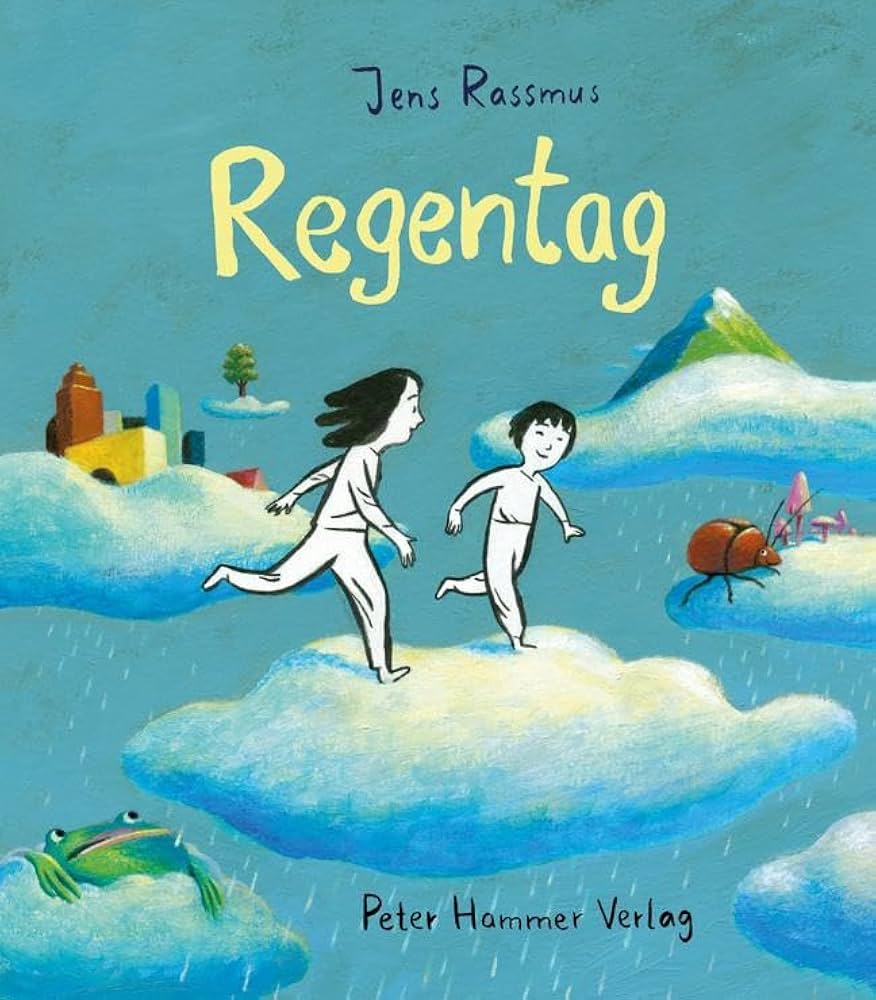Regentag by Jens Rassmus is a silent picture book that transcends the boundaries of children’s literature. Through metaphor, ambiguity, and urban imagery, it invites readers into a world of imagination, and visual storytelling, making it a powerful tool for all ages.
By Shakiba Ghiasi
Regentag (Rainy Day), a wordless picture book by German author and illustrator Jens Rassmus and published by Peter Hammer Verlag, has been nominated for the 2025 German Youth Literature Prize (Deutscher Jugendliteraturpreis) and selected for the 100 Outstanding Picture Books 2025. It offers a visual experience that is beyond its children’s book genre. Regentag invites a wide audience to observe and interpret its images without using a single word. Through simple eyeline drawings, changes in size, and an urban landscape, that perhaps represent Rassmus’ hometown of Kiel, this silent narrative speaks loudly and conveys deep and powerful messages.
Crafting Meaning: Form and Content in Regentag
In the opening scene of Regentag, two silent, nameless characters step into the frame. In a world drenched in relentless rain, where the bicycles rest motionless behind a windowpane, two children take the lead interchangeably. They can be interpreted as two protagonists, whose shifting actions and expressions drive the storytelling – essentially assuming the role of visual narrators. Although one of them, interpreted as a boy and the younger of the two, mostly follows the other character. Moreover, the ambiguity of their relationship is one of the book’s most prominent qualities, allowing readers to shape the story based on their experience, culture, and perception. In other words, the nature of the children’s relationship is intentionally left undefined, adding to the book’s interpretive openness. Are they siblings, friends, a mother and child, or even two aspects of one imagination? The illustrations offer no clear indicators because there is no dialogue, no naming, no explicit age or gender cues beyond suggestion.
The narrative turning point comes when an accidental paint spill – a visual metaphor for unleashed imagination – transforms into a playful tool, and the children begin to paint the town and streets using their footprints as brushes. Here, art is not only a play but also a medium of communication, self-expression, and even social responsibility. A giant hand later appears on the edge of the frame, calling on the children to clean up the mess. Is this hand a metaphor for a powerful Other? Or perhaps an adult? Or the voice of society, stopping spontaneous creativity and imagination? Finally, in the book’s closing scene, these visual conflicts between expression and deletion, color and grayscale are shown. The rain has stopped. The children ride their bicycles together into a city that remains mostly neutral, painted only in shadows, not sunlight.

Regentag
Peter Hammer Verlag: 2024
64 Seiten, 20 €
Using the Artful Thinking Palette
The Artful Thinking Palette, developed by Harvard’s Project Zero, offers an insightful lens for interpreting this book. Yellow represents reasoning and questioning: what’s the story? A rainy day when digital games and toys, such as smartphones or Nintendo, are set aside to make room for imagination. But what is the untold story? Perhaps isolation or the internal world of children. And what’s our story? Readers may see themselves in either of the two children, or even in the city itself, which acts as a metaphorical third character. Green stands for observing and describing, with the subtle facial lines, glances, hand gestures, and shifting distances between the characters crafting the narrative. For example, in one scene, where the girl interacts with a giant green frog (the unfamiliar Other), the boy is scared, and his look is hesitant and unsure – these visual elements convey emotional or psychological depth beyond words. Orange highlights comparing and connecting: the children’s interaction with the paint, the city, with each other, and with the Other (both human and animal) shows how the story enables cultural and interpersonal dialogue. Moreover, the motionless bicycles at the beginning of the story can be considered as a symbol of movement and connection by the end. Red focuses on interpreting and explaining that raise questions like why the girl disappears, why the boy finds her under the bed, and why the story ends with a quiet motion. Is the rain just weather, or a metaphor for their inner feelings? Blue stands for exploring complexity: although the plot seems simple, it has many layers that show the role of language, gender identity, and connection with others. Finally, Purple invites us to consider different viewpoints. This book can be interpreted from various lenses; for instance, a child from a non-European culture might read the landscape (such as wind turbines or hills) and exotic areas differently than a European reader would.
A Silent Narrative as a Tool for Dialogue
One of Regentag’s most valuable contributions is its potential in educational contexts. It reflects and mirrors aspects of society. Wordless books like this one, open to multilayered interpretations, can be powerful tools for discussions around gender, culture, society, and even ecology. Without using words, they leave space for readers to project their own cultural backgrounds, values, and experiences onto the story. Children learn not only what to see, but also why and how to see. In this process, it makes the book highly flexible for classroom discussions, so the role of the teacher becomes more of a facilitator than a lecturer. Instead of telling students what the story means, teachers can ask open-ended questions like “Why do you think the city changes?” or “What could the rain represent?” This invites students to develop their own ideas and connect them to real-world issues. Moreover, the city in this book is not a passive backdrop. It reacts to the children’s actions, gets painted, and offers shadows, and it transforms into a stage for freedom, interaction, and play, like a child’s mind. For instance, a teacher might ask: »If the city changes based on what the children do, how does that relate to how we affect our own environment or community?« These kinds of discussions encourage critical thinking, empathy, and a deeper understanding of both the story and the world. Furthermore, the absence of dialogue invites readers to focus on the changes of emotion and decision-making. In the scene where the children confront the result of their footprints, they must erase a colourful act. This sudden shift from joy to accountability mirrors the everyday conflicts between good and bad, freedom and structure, personal desires and societal expectations, and what is and isn’t accepted. Likewise, while Regentag is categorized as a children’s book, its narrative resists a fixed audience, and it engages both children and adults in meaning-making, which aligns with the interpretive openness of this book.
In Praise of a Speaking Silence
In a world full of words, noise, and imposed interpretations, Regentag by Jens Rassmus arrives as a fresh breath, inviting contemplation, which creates a deep narrative of imagination, identity, responsibility, and encounter. Its narrative creates more space for a slower, more reflective kind of reading. The encounter in Regentag is not only between two children, but also between child and environment, self and society, person and collective. Furthermore, the relation of the protagonists is not defined, offering readers room to find cultural and personal meaning. Regentag is not only a meaningful book for children but also a rich source for discussion, interpretation, and reflection at all educational levels. It invites contemplation not by giving answers, but by withholding them. It asks the reader to slow down, look carefully, and decide what the story means to them. In doing so, it becomes a powerful resource not only for children but for anyone interested in visual literacy, empathy, and critical thinking. Regentag‘s nomination for the German Youth Literature Prize also confirms its significance in a time that needs silence, as a space for thinking out of the box and a thoughtful engagement.






